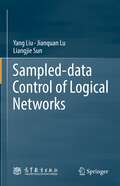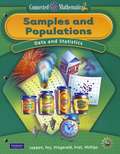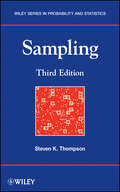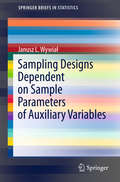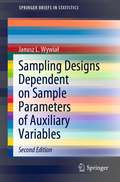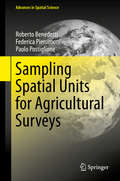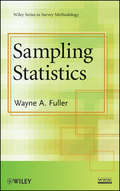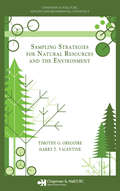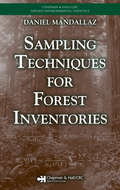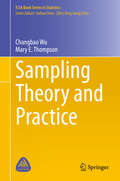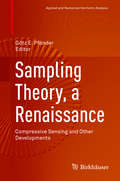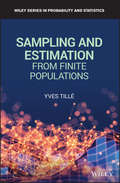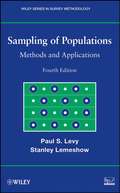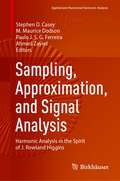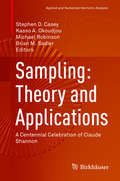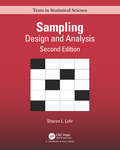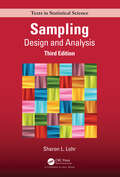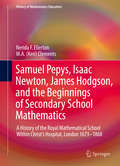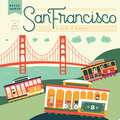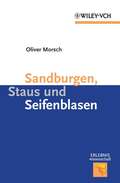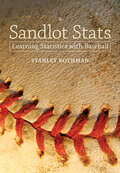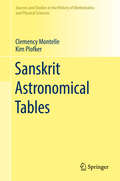- Table View
- List View
Sampled-data Control of Logical Networks
by Yang Liu Jianquan Lu Liangjie SunThis book mainly focuses on the sampled-data control of logical networks. We believe that the methods (semi-tensor product of matrices), results (recent results on Boolean control networks under periodic sampled-data control, Boolean control networks under aperiodic sampled-data control, and logical control networks under event-triggered control) and topics (logical networks) in this book have become of particular interest to readers recently. Firstly, logical networks are of interest due to their rich range of applications in biology, game theory, coding, finite automata, graph theory, and other fields. Secondly, semi-tensor product of matrices offers a useful tool for formulating, analyzing and designing controllers for logical networks. Moreover, this book is the first to introduce sampled-data control into the study of logical control networks. All research results in this book are novel and worthy of further study. The book’s content is divided into three parts (Boolean control networks under periodic sampled-data control, Boolean control networks under aperiodic sampled-data control, and logical control networks under event-triggered control), which essentially progress from easier to more difficult. In addition, corresponding examples and diagrams are included in each section to facilitate understanding.
Samples and Population: Data and Statistics (Texas)
by Glenda Lappan James T. Fey William M. Fitzgerald Susan N. Friel Elizabeth Difanis PhillipsNIMAC-sourced textbook
Samples and Populations, Data and Statistics
by Glenda Lappan James T. Fey William M. FitzgeraldNIMAC-sourced textbook
Sampling
by Steven K. ThompsonMathFeatures new developments in the field combined with all aspects of obtaining, interpreting, and using sample data. Sampling provides an up-to-date treatment of both classical and modern sampling design and estimation methods, along with sampling methods for rare, clustered, and hard-to-detect populations. This Third Edition retains the general organization of the two previous editions, but incorporates extensive new material--sections, exercises, and examples--throughout. Inside, readers will find all-new approaches to explain the various techniques in the book; new figures to assist in better visualizing and comprehending underlying concepts such as the different sampling strategies; computing notes for sample selection, calculation of estimates, and simulations; and more. Organized into six sections, the book covers basic sampling, from simple random to unequal probability sampling; the use of auxiliary data with ratio and regression estimation; sufficient data, model, and design in practical sampling; useful designs such as stratified, cluster and systematic, multistage, double and network sampling; detectability methods for elusive populations; spatial sampling; and adaptive sampling designs.Featuring a broad range of topics, Sampling, Third Edition serves as a valuable reference on useful sampling and estimation methods for researchers in various fields of study, including biostatistics, ecology, and the health sciences. The book is also ideal for courses on statistical sampling at the upper-undergraduate and graduate levels.
Sampling Designs Dependent on Sample Parameters of Auxiliary Variables
by Janusz L. WywiałThe book offers a valuable resource for students and statisticians whose work involves survey sampling. An estimation of the population parameters in finite and fixed populations assisted by auxiliary variables is considered. New sampling designs dependent on moments or quantiles of auxiliary variables are presented on the background of the classical methods. Accuracies of the estimators based on original sampling design are compared with classical estimation procedures. Specific conditional sampling designs are applied to problems of small area estimation as well as to estimation of quantiles of variables under study.
Sampling Designs Dependent on Sample Parameters of Auxiliary Variables (SpringerBriefs in Statistics)
by Janusz L. WywiałThis short monograph provides a synthesis of new research on sampling designs that are dependent on sample moments or the order statistics of auxiliary variables. The range of survey sampling methods and their applications has gradually increased over time, and these applications have led to new theoretical solutions that provide better sampling designs or estimators. Recently, several important properties of sampling designs have been discovered, and many new methods have been published. Offering an overview of these developments, this book describes sampling designs dependent on the sample generalized variance of auxiliary variables, examines properties of sampling designs proportional to functions of sample order statistics of the auxiliary variable, and takes into account continuous sampling designs. The text will be useful for students and statisticians whose work involves survey sampling, and it will inspire those looking for new sampling designs dependent on auxiliary variables.
Sampling Spatial Units for Agricultural Surveys
by Roberto Benedetti Federica Piersimoni Paolo PostiglioneThe research and its outcomes presented here focus on spatial sampling of agricultural resources. The authors introduce sampling designs and methods for producing accurate estimates of crop production for harvests across different regions and countries. With the help of real and simulated examples performed with the open-source software R, readers will learn about the different phases of spatial data collection. The agricultural data analyzed in this book help policymakers and market stakeholders to monitor the production of agricultural goods and its effects on environment and food safety.
Sampling Statistics
by Wayne A. FullerDiscover the latest developments and current practices in survey samplingSurvey sampling is an important component of research in many fields, and as the importance of survey sampling continues to grow, sophisticated sampling techniques that are both economical and scientifically reliable are essential to planning statistical research and the design of experiments. Sampling Statistics presents estimation techniques and sampling concepts to facilitate the application of model-based procedures to survey samples.The book begins with an introduction to standard probability sampling concepts, which provides the foundation for studying samples selected from a finite population. The development of the theory of complex sampling methods is detailed, and subsequent chapters explore the construction of estimators, sample design, replication variance estimation, and procedures such as nonresponse adjustment and small area estimation where models play a key role. A final chapter covers analytic studies in which survey data are used for the estimation of parameters for a subject matter model.The author draws upon his extensive experience with survey samples in the book's numerous examples. Both the production of "general use" databases and the analytic study of a limited number of characteristics are discussed. Exercises at the end of each chapter allow readers to test their comprehension of the presented concepts and techniques, and the references provide further resources for study.Sampling Statistics is an ideal book for courses in survey sampling at the graduate level. It is also a valuable reference for practicing statisticians who analyze survey data or are involved in the design of sample surveys.
Sampling Strategies for Natural Resources and the Environment (Chapman & Hall/CRC Applied Environmental Statistics)
by Timothy G. Gregoire Harry T. ValentineWritten by renowned experts in the field, Sampling Strategies for Natural Resources and the Environment covers the sampling techniques used in ecology, forestry, environmental science, and natural resources. The book presents methods to estimate aggregate characteristics on a per unit area basis as well as on an elemental basis. In addition to comm
Sampling Techniques for Forest Inventories (Chapman & Hall/CRC Applied Environmental Statistics)
by Daniel MandallazSound forest management planning requires cost-efficient approaches to optimally utilize given resources. Emphasizing the mathematical and statistical features of forest sampling to assess classical dendrometrical quantities, Sampling Techniques for Forest Inventories presents the statistical concepts and tools needed to conduct a modern for
Sampling Theory and Practice (ICSA Book Series in Statistics)
by Changbao Wu Mary E. ThompsonThe three parts of this book on survey methodology combine an introduction to basic sampling theory, engaging presentation of topics that reflect current research trends, and informed discussion of the problems commonly encountered in survey practice. These related aspects of survey methodology rarely appear together under a single connected roof, making this book a unique combination of materials for teaching, research and practice in survey sampling. Basic knowledge of probability theory and statistical inference is assumed, but no prior exposure to survey sampling is required. The first part focuses on the design-based approach to finite population sampling. It contains a rigorous coverage of basic sampling designs, related estimation theory, model-based prediction approach, and model-assisted estimation methods. The second part stems from original research conducted by the authors as well as important methodological advances in the field during the past three decades. Topics include calibration weighting methods, regression analysis and survey weighted estimating equation (EE) theory, longitudinal surveys and generalized estimating equations (GEE) analysis, variance estimation and resampling techniques, empirical likelihood methods for complex surveys, handling missing data and non-response, and Bayesian inference for survey data. The third part provides guidance and tools on practical aspects of large-scale surveys, such as training and quality control, frame construction, choices of survey designs, strategies for reducing non-response, and weight calculation. These procedures are illustrated through real-world surveys. Several specialized topics are also discussed in detail, including household surveys, telephone and web surveys, natural resource inventory surveys, adaptive and network surveys, dual-frame and multiple frame surveys, and analysis of non-probability survey samples. This book is a self-contained introduction to survey sampling that provides a strong theoretical base with coverage of current research trends and pragmatic guidance and tools for conducting surveys.
Sampling Theory, a Renaissance
by Götz E. PfanderReconstructing or approximating objects from seemingly incomplete information is a frequent challenge in mathematics, science, and engineering. A multitude of tools designed to recover hidden information are based on Shannon's classical sampling theorem, a central pillar of Sampling Theory. The growing need to efficiently obtain precise and tailored digital representations of complex objects and phenomena requires the maturation of available tools in Sampling Theory as well as the development of complementary, novel mathematical theories. Today, research themes such as Compressed Sensing and Frame Theory re-energize the broad area of Sampling Theory. This volume illustrates the renaissance that the area of Sampling Theory is currently experiencing. It touches upon trendsetting areas such as Compressed Sensing, Finite Frames, Parametric Partial Differential Equations, Quantization, Finite Rate of Innovation, System Theory, as well as sampling in Geometry and Algebraic Topology.
Sampling Theory: Beyond Bandlimited Systems
by Yonina C. EldarCovering the fundamental mathematical underpinnings together with key principles and applications, this book provides a comprehensive guide to the theory and practice of sampling from an engineering perspective. Beginning with traditional ideas such as uniform sampling in shift-invariant spaces and working through to the more recent fields of compressed sensing and sub-Nyquist sampling, the key concepts are addressed in a unified and coherent way. Emphasis is given to applications in signal processing and communications, as well as hardware considerations, throughout. With 200 worked examples and over 200 end-of-chapter problems, this is an ideal course textbook for senior undergraduate and graduate students. It is also an invaluable reference or self-study guide for engineers and students across industry and academia.
Sampling and Estimation from Finite Populations (Wiley Series in Survey Methodology)
by Yves TilleA much-needed reference on survey sampling and its applications that presents the latest advances in the field Seeking to show that sampling theory is a living discipline with a very broad scope, this book examines the modern development of the theory of survey sampling and the foundations of survey sampling. It offers readers a critical approach to the subject and discusses putting theory into practice. It also explores the treatment of non-sampling errors featuring a range of topics from the problems of coverage to the treatment of non-response. In addition, the book includes real examples, applications, and a large set of exercises with solutions. Sampling and Estimation from Finite Populations begins with a look at the history of survey sampling. It then offers chapters on: population, sample, and estimation; simple and systematic designs; stratification; sampling with unequal probabilities; balanced sampling; cluster and two-stage sampling; and other topics on sampling, such as spatial sampling, coordination in repeated surveys, and multiple survey frames. The book also includes sections on: post-stratification and calibration on marginal totals; calibration estimation; estimation of complex parameters; variance estimation by linearization; and much more. Provides an up-to-date review of the theory of sampling Discusses the foundation of inference in survey sampling, in particular, the model-based and design-based frameworks Reviews the problems of application of the theory into practice Also deals with the treatment of non sampling errors Sampling and Estimation from Finite Populations is an excellent book for methodologists and researchers in survey agencies and advanced undergraduate and graduate students in social science, statistics, and survey courses.
Sampling of Populations: Methods and Applications (Wiley Series in Survey Methodology #Vol. 318)
by Stanley Lemeshow Paul S. LevyA trusted classic on the key methods in population sampling—now in a modernized and expanded new edition Sampling of Populations, Fourth Edition continues to serve as an all-inclusive resource on the basic and most current practices in population sampling. Maintaining the clear and accessible style of the previous edition, this book outlines the essential statistical methodsfor survey design and analysis, while also exploring techniques that have developed over the past decade. The Fourth Edition successfully guides the reader through the basic concepts and procedures that accompany real-world sample surveys, such as sampling designs, problems of missing data, statistical analysis of multistage sampling data, and nonresponse and poststratification adjustment procedures. Rather than employ a heavily mathematical approach, the authors present illustrative examples that demonstrate the rationale behind common steps in the sampling process, from creating effective surveys to analyzing collected data. Along with established methods, modern topics are treated through the book's new features, which include: A new chapter on telephone sampling, with coverage of declining response rates, the creation of "do not call" lists, and the growing use of cellular phones A new chapter on sample weighting that focuses on adjustments to weight for nonresponse, frame deficiencies, and the effects of estimator instability An updated discussion of sample survey data analysis that includes analytic procedures for estimation and hypothesis testing A new section on Chromy's widely used method of taking probability proportional to size samples with minimum replacement of primary sampling units An expanded index with references on the latest research in the field All of the book's examples and exercises can be easily worked out using various software packages including SAS, STATA, and SUDAAN, and an extensive FTP site contains additional data sets. With its comprehensive presentation and wealth of relevant examples, Sampling of Populations, Fourth Edition is an ideal book for courses on survey sampling at the upper-undergraduate and graduate levels. It is also a valuable reference for practicing statisticians who would like to refresh their knowledge of sampling techniques.
Sampling, Approximation, and Signal Analysis: Harmonic Analysis in the Spirit of J. Rowland Higgins (Applied and Numerical Harmonic Analysis)
by Stephen D. Casey M. Maurice Dodson Paulo J. S. G. Ferreira Ahmed ZayedDuring his long and distinguished career, J. Rowland Higgins (1935-2020) made a substantial impact on many mathematical fields through his work on sampling theory, his deep knowledge of its history, and his service to the community. This volume is a tribute to his work and legacy, featuring chapters written by distinguished mathematicians that explore cutting-edge research in sampling, approximation, signal analysis, and other related areas. An introductory chapter provides a biography of Higgins that explores his rich and unique life, along with a bibliography of his papers; a brief history of the SampTA meetings – of which he was a Founding Member – is also included. The remaining articles are grouped into four sections – classical sampling, theoretical extensions, frame theory, and applications of sampling theory – and explore Higgins’ contributions to these areas, as well as some of the latest developments.
Sampling: A Centennial Celebration of Claude Shannon (Applied and Numerical Harmonic Analysis)
by Michael Robinson Kasso A. Okoudjou Stephen D. Casey Brian M. SadlerThe chapters of this volume are based on talks given at the eleventh international Sampling Theory and Applications conference held in 2015 at American University in Washington, D.C. The papers highlight state-of-the-art advances and trends in sampling theory and related areas of application, such as signal and image processing. Chapters have been written by prominent mathematicians, applied scientists, and engineers with an expertise in sampling theory. Claude Shannon’s 100th birthday is also celebrated, including an introductory essay that highlights Shannon’s profound influence on the field. The topics covered include both theory and applications, such as:Compressed sensingNon-uniform and wave samplingA-to-D conversionFinite rate of innovationComputational neuroscienceTime-frequency analysisOperator theoryMobile sampling issuesSampling: Theory and Applications is ideal for mathematicians, engineers, and applied scientists working in sampling theory or related areas.
Sampling: Design and Analysis (Chapman & Hall/CRC Texts in Statistical Science)
by Sharon L. LohrWhat is the unemployment rate? How many adults have high blood pressure? What is the total area of land planted with soybeans? Sampling: Design and Analysis tells you how to design and analyze surveys to answer these and other questions. This authoritative text, used as a standard reference by numerous survey organizations, teaches sampling using real data sets from social sciences, public opinion research, medicine, public health, economics, agriculture, ecology, and other fields. The book is accessible to students from a wide range of statistical backgrounds. By appropriate choice of sections, it can be used for a graduate class for statistics students or for a class with students from business, sociology, psychology, or biology. Readers should be familiar with concepts from an introductory statistics class including linear regression; optional sections contain the statistical theory, for readers who have studied mathematical statistics. Distinctive features include: More than 450 exercises. In each chapter, Introductory Exercises develop skills, Working with Data Exercises give practice with data from surveys, Working with Theory Exercises allow students to investigate statistical properties of estimators, and Projects and Activities Exercises integrate concepts. A solutions manual is available. An emphasis on survey design. Coverage of simple random, stratified, and cluster sampling; ratio estimation; constructing survey weights; jackknife and bootstrap; nonresponse; chi-squared tests and regression analysis. Graphing data from surveys. Computer code using SAS® software. Online supplements containing data sets, computer programs, and additional material. Sharon Lohr, the author of Measuring Crime: Behind the Statistics, has published widely about survey sampling and statistical methods for education, public policy, law, and crime. She has been recognized as Fellow of the American Statistical Association, elected member of the International Statistical Institute, and recipient of the Gertrude M. Cox Statistics Award and the Deming Lecturer Award. Formerly Dean’s Distinguished Professor of Statistics at Arizona State University and a Vice President at Westat, she is now a freelance statistical consultant and writer. Visit her website at www.sharonlohr.com. This edition is a reprint of the second edition published by Cengage Learning, Inc. Reprinted with permission.
Sampling: Design and Analysis (Chapman & Hall/CRC Texts in Statistical Science)
by Sharon L. Lohr"The level is appropriate for an upper-level undergraduate or graduate-level statistics major. Sampling: Design and Analysis (SDA) will also benefit a non-statistics major with a desire to understand the concepts of sampling from a finite population. A student with patience to delve into the rigor of survey statistics will gain even more from the content that SDA offers. The updates to SDA have potential to enrich traditional survey sampling classes at both the undergraduate and graduate levels. The new discussions of low response rates, non-probability surveys, and internet as a data collection mode hold particular value, as these statistical issues have become increasingly important in survey practice in recent years… I would eagerly adopt the new edition of SDA as the required textbook." (Emily Berg, Iowa State University) What is the unemployment rate? What is the total area of land planted with soybeans? How many persons have antibodies to the virus causing COVID-19? Sampling: Design and Analysis, Third Edition shows you how to design and analyze surveys to answer these and other questions. This authoritative text, used as a standard reference by numerous survey organizations, teaches the principles of sampling with examples from social sciences, public opinion research, public health, business, agriculture, and ecology. Readers should be familiar with concepts from an introductory statistics class including probability and linear regression; optional sections contain statistical theory for readers familiar with mathematical statistics. The third edition, thoroughly revised to incorporate recent research and applications, includes a new chapter on nonprobability samples—when to use them and how to evaluate their quality. More than 200 new examples and exercises have been added to the already extensive sets in the second edition. SDA’s companion website contains data sets, computer code, and links to two free downloadable supplementary books (also available in paperback) that provide step-by-step guides—with code, annotated output, and helpful tips—for working through the SDA examples. Instructors can use either R or SAS® software. SAS® Software Companion for Sampling: Design and Analysis, Third Edition by Sharon L. Lohr (2022, CRC Press) R Companion for Sampling: Design and Analysis, Third Edition by Yan Lu and Sharon L. Lohr (2022, CRC Press)
Samuel Pepys, Isaac Newton, James Hodgson, and the Beginnings of Secondary School Mathematics
by M. A. Ken Clements Nerida F. EllertonThis book tells one of the greatest stories in the history of school mathematics. Two of the names in the title--Samuel Pepys and Isaac Newton--need no introduction, and this book draws attention to their special contribution to the history of school mathematics. According to Ellerton and Clements, during the last quarter of the seventeenth century Pepys and Newton were key players in defining what school mathematics beyond arithmetic and elementary geometry might look like. The scene at which most of the action occurred was Christ's Hospital, which was a school, ostensibly for the poor, in central London. The Royal Mathematical School (RMS) was established at Christ's Hospital in 1673. It was the less well-known James Hodgson, a fine mathematician and RMS master between 1709 and 1755, who demonstrated that topics such as logarithms, plane and spherical trigonometry, and the application of these to navigation, might systematically and successfully be taught to 12- to 16-year old school children. From a wider history-of-school-education perspective, this book tells how the world's first secondary-school mathematics program was created and how, slowly but surely, what was being achieved at RMS began to influence school mathematics in other parts of Great Britain, Europe, and America. The book has been written from the perspective of the history of school mathematics. Ellerton and Clements's analyses of pertinent literature and of archival data, and their interpretations of those analyses, have led them to conclude that RMS was the first major school in the world to teach mathematics-beyond-arithmetic, on a systematic basis, to students aged between 12 and 16. Throughout the book, Ellerton and Clements examine issues through the lens of a lag-time theoretical perspective. From a historiographical perspective, this book emphasizes how the history of RMS can be portrayed in very different ways, depending on the vantage point from which the history is written. The authors write from the vantage point of international developments in school mathematics education and, therefore, their history of RMS differs from all other histories of RMS, most of which were written from the perspective of the history of Christ's Hospital.
San Francisco: A Book of Numbers (Hello, World)
by Ashley EvansonHello, World is an exciting book series that pairs early learning concepts with colorful, stylish illustrations of cities around the world. From the Golden Gate Bridge to seals to cable cars, there&’s no shortage of bright, bold, and interesting things to count in San Francisco. Explore numbers through the best the city has to offer in this gorgeous board book!
Sandburgen, Staus und Seifenblasen (Erlebnis Wissenschaft)
by Oliver MorschWarum bilden sich Staus aus dem Nichts und lösen sich genauso unverhofft wieder auf? Warum fließt Sand und kann dennoch hart wie Beton sein? Die physikalischen Gesetzmäßigkeiten hinter diesen und anderen Ereignissen sind spannend zu entdecken.
Sandlot Stats: Learning Statistics with Baseball
by Stanley RothmanSandlot Stats uses the national pastime to help students who love baseball learn—and enjoy—statistics.As Derek Jeter strolls toward the plate, the announcer tosses out a smattering of statistics—from hitting streaks to batting averages. But what do the numbers mean? And how can America’s favorite pastime be a model for learning about statistics? Sandlot Stats is an innovative textbook that explains the mathematical underpinnings of baseball so that students can understand the world of statistics and probability. Carefully illustrated and filled with exercises and examples, this book teaches the fundamentals of probability and statistics through the feats of baseball legends such as Hank Aaron, Joe DiMaggio, and Ted Williams—and more recent players such as Barry Bonds, Albert Pujols, and Alex Rodriguez. Exercises require only pen-and-paper or Microsoft Excel to perform the analyses.Sandlot Stats covers all the bases, including• descriptive and inferential statistics• linear regression and correlation• probability• sports betting• probability distribution functions• sampling distributions• hypothesis testing• confidence intervals• chi-square distributionSandlot Stats offers information covered in most introductory statistics books, yet is peppered with interesting facts from the history of baseball to enhance the interest of the student and make learning fun.
Sanskrit Astronomical Tables (Sources and Studies in the History of Mathematics and Physical Sciences)
by Kim Plofker Clemency MontelleThis groundbreaking volume provides an up-to-date, accessible guide to Sanskrit astronomical tables and their analysis. It begins with an overview of Indian mathematical astronomy and its literature, including table texts, in the context of history of pre-modern astronomy. It then discusses the primary mathematical astronomy content of table texts and the attempted taxonomy of this genre before diving into the broad outlines of their representation in the Sanskrit scientific manuscript corpus. Finally, the authors survey the major categories of individual tables compiled in these texts, complete with brief analyses of some of the methods for constructing and using them, and then chronicle the evolution of the table-text genre and the impacts of its changing role on the discipline of Sanskrit jyotiṣa. There are also three appendices: one inventories all the identified individual works in the genre currently known to the authors; one provides reference information about the details of all the notational, calendric, astronomical, and other classification systems invoked in the study; and one serves as a glossary of the relevant Sanskrit terms.
Satellite Dynamics and Space Missions (Springer INdAM Series #34)
by Alessandra Celletti Giulio Baù Cătălin Bogdan Galeş Giovanni Federico GronchiThis book discusses the design of new space missions and their use for a better understanding of the dynamical behaviour of solar system bodies, which is an active field of astrodynamics. Space missions gather data and observations that enable new breakthroughs in our understanding of the origin, evolution and future of our solar system and Earth’s place within it. Covering topics such as satellite and space mission dynamics, celestial mechanics, spacecraft navigation, space exploration applications, artificial satellites, space debris, minor bodies, and tidal evolution, the book presents a collection of contributions given by internationally respected scientists at the summer school “Satellite Dynamics and Space Missions: Theory and Applications of Celestial Mechanics”, held in 2017 at San Martino al Cimino, Viterbo (Italy). This school aimed to teach the latest theories, tools and methods developed for satellite dynamics and space, and as such the book is a valuable resource for graduate students and researchers in the field of celestial mechanics and aerospace engineering.
